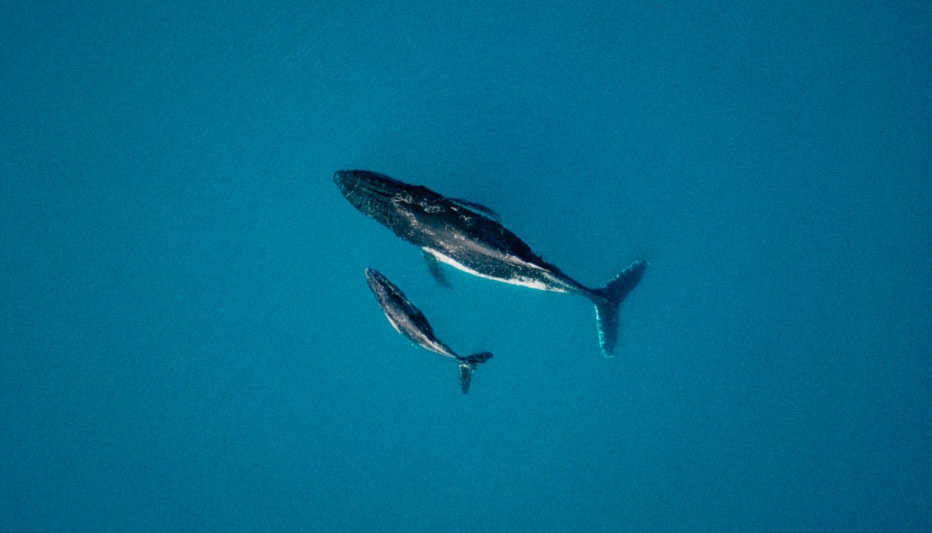Going above and beyond for whale conservation
Whales couldn’t be more important to the survival of our planet, and yet we’ve lost 80% in the last century.
Through satellite data and AI, we are collaborating with Whale and Dolphin Conservation and SPACEWHALE to try to change that – whilst at the same time pioneering new technology for marine conservation more broadly.
Whale and Dolphin Conservation (WDC), one of Deloitte’s charity partners, has a bold and brilliant ambition – aiming to reverse the global decline in whales and dolphins. In the last century we’ve lost 80% of the biomass of whales. A concerning statistic. And when we consider that these marine mammals are significantly important to our planet’s survival, it’s even more concerning.
Traditionally, to help conserve whales, conservationists have needed to be out in the field – literally in the ocean and in aircraft – manually mapping whales and tracking their behaviour, including migration routes, diet and fluctuating population numbers. This informs governments on what areas should become Marine Protected Areas and in turn helps protect and increase whale populations.
However, this time-intensive and laborious process means there is a considerable delay between collecting data and scientists being able to interpret it. This is an issue when they’re trying to act quickly to prevent further damage to whales.
WDC asked Deloitte, is there a better, faster way? Can emerging technologies transform this process and help us understand: where are the whales and how many are there?
What few people realised until recently was just how much we need whales to save us… Whales play a huge role in helping the ocean absorb carbon and mitigate the threat of climate and ecological breakdown.
Chris Butler-Stroud, CEO of WDC
Why did WDC need to try a new approach?
Whilst space technologies were not top of mind for WDC, they were bold enough to want to take a leap of faith, test pioneering tech and explore the ways space data might help unlock new ways of working.
Enter GRAVITY Challenge – our open innovation spacetech programme.
It enables clients to pose challenges that spacetech might be able to solve – and connects them to those pioneers developing new applications for space technologies and space data.
Through GRAVITY Challenge, we connected WDC with Bioconsult SH’s new tech service, SPACEWHALE. SPACEWHALE offers AI-based detection of large whales through very high-resolution satellite imagery. Collaborating with WDC, we ran a proof of concept using the service to test if researchers can explore remote areas they couldn’t reach before, and discover, report and analyse the mapping of whales in weeks rather than decades.
Through the pilot, WDC can look at historical and current data in remote parts of the ocean almost instantaneously, all from their desktops.
And it doesn’t end there, Chris Butler-Stroud explains that sometimes it takes a fresh approach to think of new ways to use the data. “In the past it’s been ignorance that’s been killing whales and dolphins. We just didn’t know what was happening and we didn’t understand. Space technology is the key to opening up and then innovating. And that’s what comes from this kind of collaboration, you start to think of new ways to use the data.”
“In the beginning, we wouldn’t really have even contemplated using space technology, it just seemed so far away from our day-to-day lives. But really, Deloitte are an amazing catalyst.
They can identify partners, they can bring people together. And I think that really adds value to what we’re trying to do in terms of conservation.”
Chris Butler-Stroud, CEO, WDC

What did it take to do something new?
With our sights set on transforming the ways in which whales are mapped, we helped WDC to:
- Consider the potential of space technology to support them.
- Articulate the challenge to be solved and the value this would create for them and broader conservation efforts if a solution could be developed.
- Connect with our ecosystem of innovators through the GRAVITY Challenge, inviting them to put forward their proposals.
- Assess proposals from innovators to help WDC confidently determine which solution should be taken to proof-of-concept stage.
- Bring to bear the knowhow of our Deloitte Space practice and Sustainability and Climate experts to help shape a proof of concept between SPACEWHALE, and WDC. This would provide a baseline monitoring of large whales in poorly studied offshore areas.
What was the impact?
Whilst the initial phase of the proof of concept has been completed, the overall study will complete in October 2024.
In the meantime, reviewers are validating the results of this pilot to verify that the algorithm has been able to successfully distinguish between whales and inanimate objects like boats and rocks.
Based on results to date, WDC are really excited about the new opportunities this technology can unlock for them and will continue exploring their options in this brave new space.






